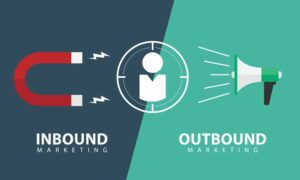This nugget of wisdom came out of a conversational marketing workshop that I attended at this year’s Inbound conference.
Conversational Marketing is brand new, about a year old, and everybody is figuring out how to use it. When I first heard the term, I thought that it was about using Bots to have fake conversations with your site visitors. While that’s certainly part of conversational marketing, if that’s the only focus then we’re totally missing the mark.
Here’s the deal: Conversational Marketing isn’t about automating conversations with your prospects, leads, and customers. It’s about starting them. It’s about being human.
What is conversational marketing?
I read a statistic recently that didn’t shock me at all. It said that the sales technique that has the highest close rate is face to face communication. In other words, if a salesperson can get in front of a prospect, they have the highest chance of closing the deal. Why is that? Because when you’re face to face with someone, you connect in a much more authentic way. You can judge body language and gestures in addition to tone of voice and word choice. More importantly, it gives you the opportunity to connect on a human level and have a more normal conversation. Makes sense.
So if you have the best chance for success when you connect personally with your customers, then why are we trying to take the human element out of our sales process and calling it, ironically, conversational marketing?
Conversational Marketing is about starting a conversation with a potential customer. It’s about re-introducing the human element to this thing called marketing that has become, for most brands most of the time, a really impersonal experience.
Here’s the thing. Marketers have gotten really good at generating leads. Maybe too good. During these big marketing meetings that we all have, one comment that always comes up is whether an idea will scale. Yeah, 1 lead is great. 10 leads is great. 100 leads, 500 leads, 1000 leads, not so great. How do you follow up with 1,000 leads? You have to automate in order to filter leads out and help your sales team decide where to put their energy. We’re just too good at our job. ????
So, let’s set the record straight. Fifteen years ago, inbound marketing burst onto the scene and marketers were able to cast a really wide net for our clients. We began to research how people searched for information and we wrote content that we knew our prospects would find and be interested in. Unfortunately, not everybody that read our content was a qualified buyer. Our salespeople saw a huge influx of leads, many of which were a poor fit for our products and services. Salespeople had no way of focusing on the leads that were most important. So began the feud between Marketing departments and Sales departments.
As technology has progressed since then, we have created tools for automatically filtering out bad-fit clients. We’d use things like Progressive Profiling, where our forms adapt based on what we already know about the prospect. As we build out these full profiles, we learned the industries, the job titles, the company size, that led to our best-fit clients and we would use this information to help our salespeople prioritize. We would take a couple of weeks to send automated email to judge response and help our salespeople decide if the prospect is truly interested in our company or if they’re just a tire-kicker interested in an article that we wrote once.
From the company’s point of view, this works. Kind of.
From your buyer’s perspective, this doesn’t work. Really, we’re doing two things, aren’t we?
1) We’re sending a bunch of people who are never going to buy from you a bunch of info that they don’t really care about.
2) We’re forcing the people that actually do want to buy from you to go through this long funnel so that we can feel confident that they’re ready to buy before we ‘waste’ a bunch of time on them.
Both of these groups are ticked off at marketers because we’re not speaking to the right person in the right way. This is especially dangerous because we’re creating all kinds of extra hoops and processes that our buying customers – our best prospects – have to jump through to buy from us.
Let me ask a question: When did not talking to our customers become the goal? When did we decide that a marketing strategy had to be scalable in order to be effective? Remember, the number one best way to sell is face-to-face, personal conversations. So why are acting like we need to avoid this at all costs?
This reason is why conversational marketing can be so powerful. When you start to really wrap your head around conversational marketing, it’s not too different than the old days when you would send an email from your AOL account and you expected the person you emailed to send you an answer back. That’s the textbook definition of one-to-one communication. The point is not to automate a whole conversation. Instead, you’re saying, “Hey, I know that you’re a human. I’m also a human. If you let me know what you need, I’ll meet you there.”
It’s okay to have a funnel (although in 2018 the marketing funnel is dead). But if your buyer doesn’t want to go through the whole funnel, don’t make them. Don’t force your customers through your process.
How to Make Conversational Marketing Work For You?
Well, most people think about live chat, and that’s a huge part of it. Just about every website that I go to has a little pop up asking me if I want to talk. No, I don’t want to talk.
There’s a peculiar ritual that happens when you walk into a brick-and-mortar store. The salesperson asks, “Can I help you find anything?” or “Anything in particular you’re looking for?” and you say, “No thanks, I’m just looking around.” But we’re not just looking around, are we? We know we want a shirt but we want to see for ourselves because we’re independent, damnit, and we don’t need your help to find the shirt section. Until we get there and we find the shirt we want, but they don’t have our size. Now we’re mad because the salesperson is on the other side of the department. The poor salesperson just can’t win. Wanna know why?
Because they’re asking open-ended questions and they’re getting crap answers from us. If the store sells shirts and pants, wouldn’t it be better to ask, “Welcome! Are you looking for shirts or pants today?” There’s only two good answers to that question: 1) shirts or 2) pants. I guess 3) Something else, but that’s all the store sells so why come in?
Here’s my point: Don’t pop up a live chat thing and ask if people want to talk. I’ll go ahead and answer that for you: they don’t want to talk. Instead ask them a question about themselves. “Hey, are you in marketing or in sales?” “Hey, are you thinking about higher education?” “Hey, are you trying to understand conversational marketing?”
Get them talking about themselves. The theory is that people would rather talk about themselves than talk about nothing. You’ll get more interactions, and you’ll get more leads.
Keep in mind, you don’t have to do this on every page of your site. Maybe just put them on those more targeted, bottom of the funnel pages.
Chatbots are taking over chat right now, and they’re kind of frustrating, aren’t they? We immediately know we’re not dealing with a human and they often don’t answer our questions and they can be a bad experience.
I think chatbots can be a really powerful tool to begin conversations. I don’t think the technology is at the point where that can be someone’s only interaction with your brand. It just probably won’t be a positive experience.
So if you’re going to use them, use them to start conversations, not to handle the conversation. You’re going to need to think through very carefully how and when you transition between the bot and the human. For my website, I want to know if the person is in marketing or sales. I’d like for them to tell me a little bit about their company, and I’d like for them to choose from a selection of pain points that I know I can help with. Once they do that, they’ll have a few different options of how they want to continue the conversation with me, a human. There’s a link to book a meeting or I can reach out through email or phone (their call).
Final point: Let’s think a little bit about how we send email. The majority of marketers think that they send too much email, which means we definitely send too much email. Here’s the problem with automated email. A lot of the time, it’s not personal. If they were a hot lead and they fell off the face of the earth, we’re sending them newsletters and emails to resources and all kinds of other things. I would suggest toning it down and instead sending these one of these two emails (that take about 4 seconds to write). Not branded, no templates, just a plain text email.
“Hey FirstName, are you still interested in XYZ?”
“HeyFirstName, did you find a solution for XYZ?”
That’s it. Why? Because that’s how people talk to each other. Here’s what will happen: they’ll respond, because we’re indicating that we want to start a conversation with them, instead of talking at them.
So, as marketers, stop telling so much. Start asking questions. Only then can you start to have real, human conversations with your site visitors, your prospects, and your customers.
PS. Don’t send your mail from a noreply@company.com address.





